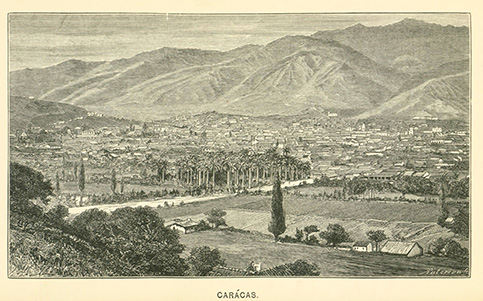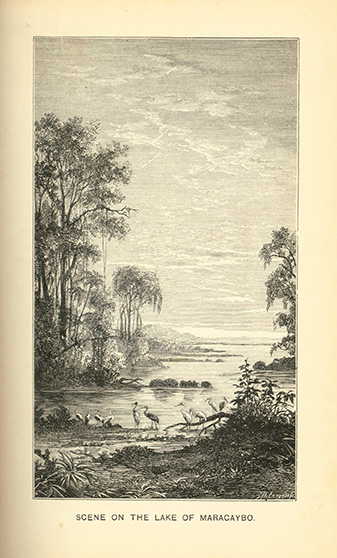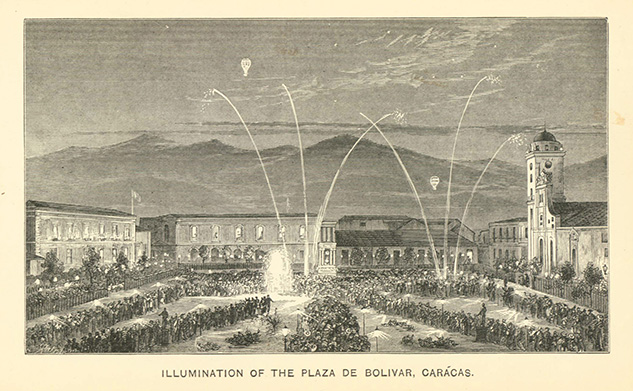By: Savannah Gulick, Archives & Rare Books Library Student Assistant
 With one glance at the current news in Venezuela, horror ensues as you witness the atrocities that Venezuelans are enduring on a daily basis. Corrupt politicians, hyperinflation, big oil, blackouts and a lack of access to food, water, and other necessities are just the beginning. In one of my Spanish courses, our professor had us pull newspaper articles about the conflict and one particular article still comes to mind: “In Venezuela, Cooking With Firewood as Currency Collapses” (https://www.nytimes.com/2017/09/02/world/americas/venezuela-nicholas-maduro-inflation-economic-collapse.html?rref=collection%2Ftimestopic%2FVenezuela). Black markets are thriving and charging obscene amounts for items like propane gas, eggs and sugar, which in turn leads to people relying on firewood for heat and food. In this century, it is hard to fathom how quickly a country can collapse and what that means for the citizens. However, the stark reality is that countries can fall in a week if enough corruption, unrest, and poor distribution of wealth exists.
With one glance at the current news in Venezuela, horror ensues as you witness the atrocities that Venezuelans are enduring on a daily basis. Corrupt politicians, hyperinflation, big oil, blackouts and a lack of access to food, water, and other necessities are just the beginning. In one of my Spanish courses, our professor had us pull newspaper articles about the conflict and one particular article still comes to mind: “In Venezuela, Cooking With Firewood as Currency Collapses” (https://www.nytimes.com/2017/09/02/world/americas/venezuela-nicholas-maduro-inflation-economic-collapse.html?rref=collection%2Ftimestopic%2FVenezuela). Black markets are thriving and charging obscene amounts for items like propane gas, eggs and sugar, which in turn leads to people relying on firewood for heat and food. In this century, it is hard to fathom how quickly a country can collapse and what that means for the citizens. However, the stark reality is that countries can fall in a week if enough corruption, unrest, and poor distribution of wealth exists.
Despite these horrible times, Venezuelans still carry so much pride for their country as they have for centuries. Venezuela has long been home to some of the most beautiful sights on earth: from Angel Falls to the ancient city of Caracas founded in 1567. Yet, those who only read about the violence and corruption in the country overlook these sights. Because of that, I want to highlight the beautiful history of this nation and resilient nature of the people in this blog through a few of the historical travel volumes that are part of the rare books collection in the Archives and Rare Books Library.
Although not as illustration-dense as other books I chose, I could not pass up Jornadas Nauticas: Relacion del Descubrimiento del Rio Apure (call no. SpecCol RB F2311 .C33) because it is printed entirely in Spanish and it is the oldest book in the collection about a  travel expedition throughout Venezuela (1648). The volume discusses the discovery of a new river (i.e. an important water source for the Spanish settlers). Settlers in the Llanos (plains) region of Venezuela relied on a cattle farming, which the economy at the time was heavily based upon. The new river discovery created easier access to water and crops for the cattle and the ranchers. The image pulled from this book is an engraving of where the new river lies in relation to the massive Orinoco River– one of the longest rivers in South America – as well as other smaller tributaries.
travel expedition throughout Venezuela (1648). The volume discusses the discovery of a new river (i.e. an important water source for the Spanish settlers). Settlers in the Llanos (plains) region of Venezuela relied on a cattle farming, which the economy at the time was heavily based upon. The new river discovery created easier access to water and crops for the cattle and the ranchers. The image pulled from this book is an engraving of where the new river lies in relation to the massive Orinoco River– one of the longest rivers in South America – as well as other smaller tributaries.
In James Mudie Spence’s The Land of Bolivar, Volumes I & II (call no. SpecCol RB F2308 .S7 1878), the author details his 18-month long stint in Venezuela from 1871 to 1872. As I was perusing  the collection of Venezuelan books, I noticed that Spence’s story highlighted the era after the 25-year long civil war that Venezuela endured. Despite the lengthy war they had to overcome, the pride of the people in the country is evident throughout Spence’s encounters with the locals. I particularly liked the dedication: “To the people of the Republic of Venezuela, but more especially to those whose efforts are directed to the regeneration of their country, this work is dedicated”. Considering the current situation in Venezuela, I thought the dedication is still applicable to the people fighting every day to regain control in their country. The illustrations – mostly rendered by the author himself with a pencil – highlight the natural beauty and urbanized cities that are at risk of destruction today. The few that I have selected really capture the contrasting beauty of the nature and cities throughout Venezuela.
the collection of Venezuelan books, I noticed that Spence’s story highlighted the era after the 25-year long civil war that Venezuela endured. Despite the lengthy war they had to overcome, the pride of the people in the country is evident throughout Spence’s encounters with the locals. I particularly liked the dedication: “To the people of the Republic of Venezuela, but more especially to those whose efforts are directed to the regeneration of their country, this work is dedicated”. Considering the current situation in Venezuela, I thought the dedication is still applicable to the people fighting every day to regain control in their country. The illustrations – mostly rendered by the author himself with a pencil – highlight the natural beauty and urbanized cities that are at risk of destruction today. The few that I have selected really capture the contrasting beauty of the nature and cities throughout Venezuela.
One of the last chapters in the first volume also illuminates on the strength of the people. The new president who offered peace to a country torn by civil strife responded to the cheers of his people: “Venezuela is now entering upon the true path of peace and progress, and the nation will quickly take her proper place amongst the republics of the New World. To this end I pledge my word, and to it I dedicate my strength”. Following this proclamation, the City of  Caracas celebrated into the night and Spence recalls the joy and peace that were present on everyone’s face.
Caracas celebrated into the night and Spence recalls the joy and peace that were present on everyone’s face.
Another factor for exploring the books on this particular country is the upcoming June 9 soccer game on campus in Nippert Stadium between the U.S. men’s national team against the Venezuelan national team! The game will be a great match and the pride that Venezuelans have for soccer and their homeland will continue to shine through even now in the country’s darkest hours.
For more information about the early exploration of Venezuela or other rare travel accounts around the globe, visit the Archives & Rare Books Library on the 8th floor  of Blegen Library. We are open Monday through Friday, 8:00 am-5:00 pm. You can also call us at 513.556.1959, email us at archives@ucmail.uc.edu, visit us on the web at http://www.libraries.uc.edu/arb.html, or have a look at our Facebook page, https://www.facebook.com/ArchivesRareBooksLibraryUniversityOfCincinnati
of Blegen Library. We are open Monday through Friday, 8:00 am-5:00 pm. You can also call us at 513.556.1959, email us at archives@ucmail.uc.edu, visit us on the web at http://www.libraries.uc.edu/arb.html, or have a look at our Facebook page, https://www.facebook.com/ArchivesRareBooksLibraryUniversityOfCincinnati

